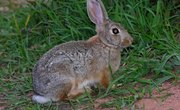Curing, or "tanning," animal skins requires significant work as well as immediate action once the animal has been killed. Skins that haven't begun the tanning process within a few hours of being removed from the animal will likely not result in good hides. However, with the proper equipment, chemicals, and a bit of work, tanning an animal skin can be done at the home with a result of professional quality, assuming you adhere to proper guidelines.
Knife
Salt
7 gallons water
2 large plastic trash cans (30 gallon) and one lid
2 lbs bran flakes
16 cups plain or pickling salt (not iodized)
4-foot wooden stirring stick
3½ cups battery acid (from auto parts store)
2 boxes baking soda
Wood rack or stretcher
Neat's-foot oil
Nails
Wire bristle brush
Be extremely careful during the battery acid phase as it is a particularly toxic chemical. Wear safety clothing to reduce the risk of injury. Dispose of the tanning solution by first neutralizing it with several boxes of baking soda. Make sure it is in a well-ventilated space as it bubbles and releases potentially toxic gases. Take the solution to a chemical waste disposal service.
Cool the animal skin immediately once you have removed it from the animal's body by placing it in the shade on a cool surface such as concrete. Make sure no visible tissue or fat is left on the hide by using a knife to cut the remaining pieces away.
Use plain, uniodized salt to cover the flesh side of the skin once it feels cold to the touch. Be generous with salting the skin as a hide from a deer will use between three and five pounds of salt to properly cure.
Transport the hide somewhere out of reach of predators and make sure that it lies completely flat. Add more salt if you lost any during the transportation. Let the skin sit until it is crispy dry. Once the skin is completely dry, assemble the tanning ingredients and tools required as outlined in the "Things You'll Need" section.
Let the skins soak in fresh water for several hours before you begin the tanning process. Start the tanning solution by first boiling three gallons of water and pouring it over the bran flakes in one of the trash cans to sit for one hour. Strain out the bran flakes but keep the brown water solution.
Put 16 cups of salt in a trash can and bring four gallons of water to boil. Pour the boiling water into the trash can with salt and mix it until all of the salt dissolves. Add the bran flake and water solution (not the flakes themselves) to the salt water.
Wear gloves and a long sleeve shirt and pour the battery acid into the solution once it is lukewarm, then stir the solution. Do not let the battery acid splash or spill. Remove the animal skin's dried inner skin and add the hide to the solution. Use the stirring stick to push the hide into the solution and stir until the hide is saturated. Let it soak for 40 minutes and stir occasionally.
Fill the first trash can with lukewarm water, and once the hides have finished soaking in the tanning solution, stir them into the lukewarm water. Stir the skins in the water and change the water as it becomes dirty. Continue this rinsing process for about five minutes.
Add about one box of baking soda into the rinsing water to rid the animal hide of excess acid. Take the hides from the rinse and hang them over something sturdy to drain. Use a sponge and swab the skin with one ounce of neat's-foot oil.
Nail the hide to a stretcher by gently pulling the skin as you tack it so that it has some tension. Place the hide on its stretcher somewhere cool to dry and check it every day until you notice that it is flexible yet dry to the touch.
Remove the hide from the stretcher, place it skin-side up, and use a wire bristle brush to gently comb the hide in order to soften the skin. Let sit another day or so before using for whatever project or placement it was intended for.
Items you will need
Warnings
References
Warnings
- Be extremely careful during the battery acid phase as it is a particularly toxic chemical. Wear safety clothing to reduce the risk of injury. Dispose of the tanning solution by first neutralizing it with several boxes of baking soda. Make sure it is in a well-ventilated space as it bubbles and releases potentially toxic gases. Take the solution to a chemical waste disposal service.
Writer Bio
Bryan Schatz began writing in 2009. His articles appear on eHow and LIVESTRONG.COM, where he specializes in travel, wood and metal craft and fitness topics. Schatz holds a Master of Arts in education and a Bachelor of Arts in community studies from the University of California, Santa Cruz.



